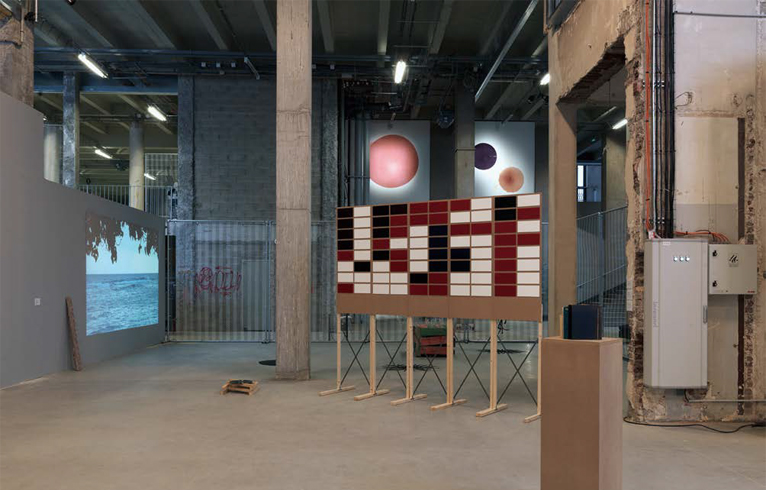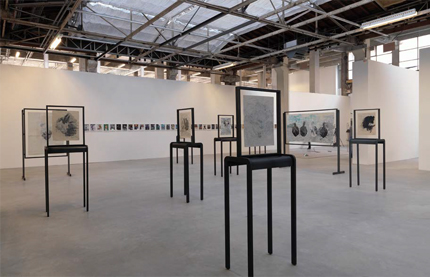LA TRIENNALE 2012: INTENSE PROXIMITY
| September 29, 2012 | Post In LEAP 16

Once known as La Force de l’Art, the Paris Triennale was founded in 2006 by the Ministry of Culture as a showcase for French contemporary art. The previous two editions paraded a dependably bland selection of local wares through the center of the Grand Palais, but the anticipated international acclaim never materialized and La Force de l’Art ended up speaking more to the scene’s shortcomings.
With this third Triennale, the rules have shifted to include artists “working within the French scene,” giving artistic director Okwui Enwezor— no Frenchman himself, mind you— room to play with the criteria for how that scene is defined. A lot of room. The exhibition has been moved to the Palais de Tokyo, making it the first to take full advantage of the recent renovation that has rehabilitated 14,000 square meters of previously unused space (bringing the museum’s total area to a staggering 22,000 square meters.) It’s a massive venue, but Enwezor fills it to capacity, recruiting a team of four accomplished assistant curators— Mélanie Bouteloup, Abdellah Karroum, Emilie Renard, and Claire Staebler— to handle the roster of over 120 artists and the equally ambitious program of publications, performances, and offsite projects.
In its rhetoric, “Intense Proximity” seeks to explore “the poetics of ethnography,” concentrating on the ways the discipline challenged Western monopolies on representation by introducing other viewpoints. As ethnography itself is never a definitive science, the exhibition’s title refers to its strategy of recognizing heterogeneous perspectives by bringing them into contact with one another. This strategy leaves more than traditions of representation at stake; it would seem Enwezor’s true aim is to confront France with its own colonialist history. Rather than celebrate a national aesthetic, this Triennale slyly dismantles the very notion of a nation.
A self-proclaimed “anti-museum par excellence,” the Palais de Tokyo has always challenged curators with its rounded walls and soaring ceilings. Now, the insistently raw, industrial character of the new basement levels breaks even further from the white cube. Paint appears only in patches along the intrusive architectural elements, while the entire building hums with the buzzing of ventilation systems and electrical wires. (The museum’s “Modules” program literally finds work crouching under staircases or hiding out in concrete hulls.)
“Intense Proximity” uses this over-stimulative environment to a curatorial end, as a means to replicate the barrage of competing references and networks engaged when encountering a work of art. To understand how such “proximity” functions, take for example one of the exhibition’s main intersections: on the floor in the center of the space sit two monitors, attached but facing in opposite directions like a double-sided megaphone. Their screens alternate a selection of video and lectures from Adrian Piper, which range from documentation of her Mythic Being to a collection of recent film clips featuring “ethnic outsiders” teaching white people in black ties to break loose and dance. Above the monitors, 75 African masks photographed by Walker Evans send their empty gazes out across the room to Meschac Gaba’s Marriage Room, which answers back with strains of Dusty Springfield’s “I Only Want to be with You!” A component of Gaba’s mobile Museum of Contemporary African Art, the installation oscillates between an anthropological archive and an open-air market, displaying artifacts from the artist’s wedding on wooden palettes covered with newspaper. In the accompanying images, Gaba’s beaming blonde bride looks past Evans’ masks, and across the room to Victor Man’s dark Deposition (2008) which suggests a ceremony for a far less joyous occasion. Beneath the canvas, Piper’s monitor is now broadcasting a clip from the 2003 film Head of State, with the comedian Chris Rock leading a room full of politicians in a choreographed grind to Nelly’s “Hot in Herre.”
The experience is not so much a conversation as a confluence. Thankfully, the various undercurrents of identity politics pool at certain points in the exhibition, giving the viewer a chance to stop and rethink the relationships between the objects encountered. For instance, neatly tucked behind Evans’ African Negro Art Portfolio is a quiet enclave of photographs and research materials from Claude Levi-Strauss and Pierre Verger. Looking at Levi-Strauss’ notebooks, one is reminded of what informs one’s readings of what it means when a Beninese artist takes a Dutch wife or what just it is about Piper’s Mythic Being that makes it so different, so appealing.

On the other side of that same wall, Lorraine O’Grady attempts subjective anthropology of her own with the stunning Miscegenated Family Album. The set of sixteen diptychs pairs depictions of the Egyptian queen Nefertiti with photographs of O’Grady’s sister Devonia, carving out a potential lineage from the likeness in their wide, almond-shaped eyes and tightlipped smiles. This kind of cultural cross-dressing plays— perhaps more problematically— into the work of Lili Reynaud Dewar, who experiments with black-face in an ode to Josephine Baker that comes off as half courtship and half a critical dismantling of the dancer’s tricks. In a framed performance still, Reynaud Dewar’s tiny, blackened body is barely distinguishable from the sculptures in her studio, but in the video footage of the same performance, this body springs to life, shimmying and side-stepping across the floor. The title of Reynaud Dewar’s performance—“What a pity you’re an architect, Monsieur. You’d make a sensational partner” (After Josephine Baker)—references an alleged dalliance between Le Corbusier and Baker, during which the esteemed architect attempted to seduce the “Ebony Venus” by dressing up in her image. In the context of the Triennale, this history is left out of the wall label; instead the video of the performance is clumsily folded into a larger installation of “white” objects— from a marble torso of a woman to a copy of Brian O’Doherty’s Inside the White Cube— all smeared in various stages of black-face. This cheekiness is cheap, bereft of the electric thrill of whatever it was the artist was on to in her studio. (To quote a poster from Y to Barrada’s Modest Proposal: “I’M NOT EXOTIC, I’M EXHAUSTED.”)
If the exhibition presumes to bring distant ideas into proximity, then it also assumes that the original distance between these positions can be measured in Fear. After all, FEAR EATS THE SOUL, as Rirkrit Tiravanija reminds us, with a spray-painted nod to Fassbinder that covers the entire wall of the lobby. Fear leers before Jean-Luc Moulène’s grisly Filles d’Amsterdam (2004) who lie folded up for inspection like so many grocery store chickens; it provides the punch lines for Claude Clusky’s tongue-in-cheek Town&Country collages, which assign models death sentences according to their simulated activity. (The brunette languorously stretched out in a fur-lined sleeping bag is fated “To Die in a Cave,” while another getting a shampoo, “To Die on a Bad Hair Day.”) Fear even steps in and fills in the story line for Timothy Asch’s controversial 1975 documentary film, The Ax Fight, in which the ethnographer projects his own reading on what appears to be a brawl between factions of a Yãnomãmi tribe in Southern Venezuela (the same society whose drawings of birds make up one crux of Lothar Baumgarten’s Fragmento Brasil). Eventually, Tiravanija’s faux graffiti eventually finds its printed echo in the panic-mongering newspaper headlines of Antoni Muntadas’ The Construction of Fear tucked in the very back corner of the basement.
But what constitutes this Fear? At first, it may read as a run-of-the-mill Fear of the Other, but then Enwezor and his curators are angling to tease out something more self-reflexive. At Bétonsalon, one of the Triennale’s offsite venues, the parallel project “Tropicomania: The Social Life of Plants” purports to track socioeconomic relations through the movement of seeds (or pineapples, as in the case of Amos Gitai’s Ananas). What it really tracks, however, is France’s still very harried relationship with its recent history (as illustrated in a wry Pablo Bronstein drawing of a rococo clock, decorated with a motif of the tropical produce from various colonies coming together for Paris’ fruit salad). The entire exhibition could be encapsulated in the documents surrounding the sleight of hand that turned the “Colonial Gardens” of the bois de Vicennes— the site of the notorious colonial exhibitions of 1907 and 1931— into the more docile “Garden of Tropical Agriculture.” With the Triennale as a whole, however, Enwezor is not interested in unmasking some grand substitution; what he is pointing to is indeed an “Intense Proximity,” by revealing just how little distance lies between France and its colonial past.
Kate Sutton


